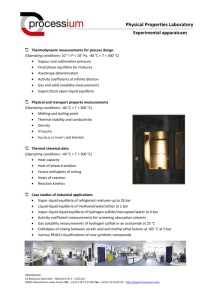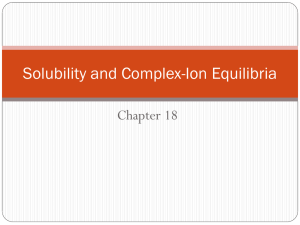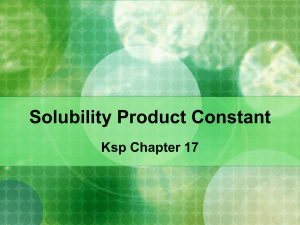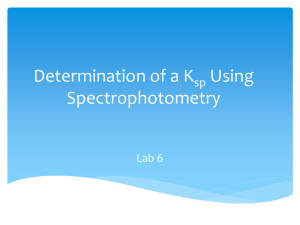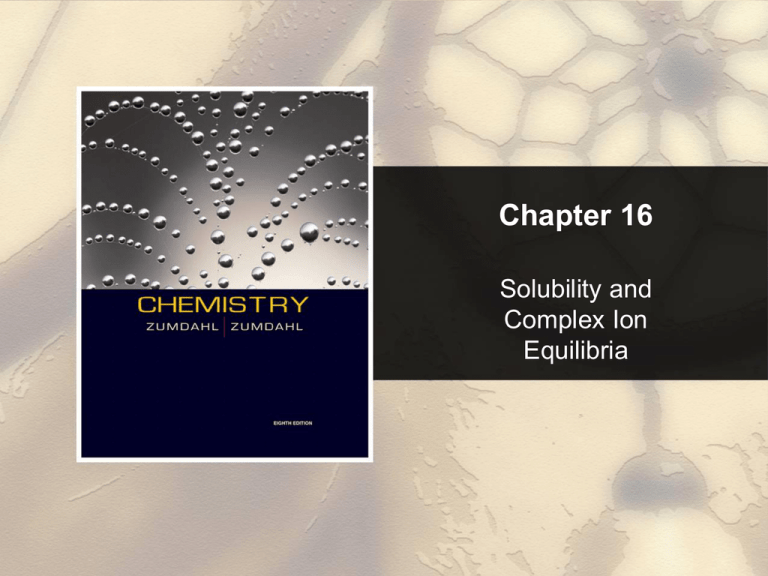
Chapter 16
Solubility and
Complex Ion
Equilibria
Chapter 16
Table of Contents
16.1
16.2
16.3
Solubility Equilibria and the Solubility Product
Precipitation and Qualitative Analysis
Equilibria Involving Complex Ions
Copyright © Cengage Learning. All rights reserved
2
Section 16.1
Solubility Equilibria and the Solubility Product
Solubility Equilibria
• Solubility product (Ksp) – equilibrium constant;
has only one value for a given solid at a given
temperature.
• Solubility – an equilibrium position.
Bi2S3(s)
2Bi3+(aq) + 3S2–(aq)
2
2
K sp = Bi S
3+
3
Return to TOC
Copyright © Cengage Learning. All rights reserved
3
Section 16.1
Solubility Equilibria and the Solubility Product
Concept Check
In comparing several salts at a given
temperature, does a higher Ksp value always
mean a higher solubility?
Explain. If yes, explain and verify. If no,
provide a counter-example.
No
Return to TOC
Copyright © Cengage Learning. All rights reserved
4
Section 16.1
Solubility Equilibria and the Solubility Product
Exercise
Calculate the solubility of silver chloride in
water. Ksp = 1.6 × 10–10
1.3×10-5 M
Calculate the solubility of silver phosphate in
water. Ksp = 1.8 × 10–18
1.6×10-5 M
Copyright © Cengage Learning. All rights reserved
Return to TOC
5
Section 16.1
Solubility Equilibria and the Solubility Product
Concept Check
How does the solubility of silver chloride in
water compare to that of silver chloride in an
acidic solution (made by adding nitric acid to
the solution)?
Explain.
The solubilities are the same.
Return to TOC
Copyright © Cengage Learning. All rights reserved
6
Section 16.1
Solubility Equilibria and the Solubility Product
Concept Check
How does the solubility of silver phosphate in
water compare to that of silver phosphate in an
acidic solution (made by adding nitric acid to
the solution)?
Explain.
The silver phosphate is more soluble in an acidic
solution.
Return to TOC
Copyright © Cengage Learning. All rights reserved
7
Section 16.1
Solubility Equilibria and the Solubility Product
Concept Check
How does the Ksp of silver phosphate in water
compare to that of silver phosphate in an
acidic solution (made by adding nitric acid to
the solution)?
Explain.
The Ksp values are the same.
Return to TOC
Copyright © Cengage Learning. All rights reserved
8
Section 16.1
Solubility Equilibria and the Solubility Product
Exercise
Calculate the solubility of AgCl in:
Ksp = 1.6 × 10–10
a) 100.0 mL of 4.00 x 10-3 M calcium chloride.
2.0×10-8 M
b) 100.0 mL of 4.00 x 10-3 M calcium nitrate.
1.3×10-5 M
Return to TOC
Copyright © Cengage Learning. All rights reserved
9
Section 16.2
Atomic Masses
Precipitation
and Qualitative Analysis
Precipitation (Mixing Two Solutions of Ions)
• Q > Ksp; precipitation occurs and will continue
until the concentrations are reduced to the point
that they satisfy Ksp.
• Q < Ksp; no precipitation occurs.
Return to TOC
Copyright © Cengage Learning. All rights reserved
10
Section 16.2
Atomic Masses
Precipitation
and Qualitative Analysis
Selective Precipitation (Mixtures of Metal Ions)
• Use a reagent whose anion forms a precipitate
with only one or a few of the metal ions in the
mixture.
• Example:
Solution contains Ba2+ and Ag+ ions.
Adding NaCl will form a precipitate with Ag+
(AgCl), while still leaving Ba2+ in solution.
Return to TOC
Copyright © Cengage Learning. All rights reserved
11
Section 16.2
Atomic Masses
Precipitation
and Qualitative Analysis
Separation of Cu2+ and Hg2+ from Ni2+ and Mn2+ using H2S
• At a low pH, [S2–] is relatively low and only the
very insoluble HgS and CuS precipitate.
• When OH– is added to lower [H+], the value of
[S2–] increases, and MnS and NiS precipitate.
Return to TOC
Copyright © Cengage Learning. All rights reserved
12
Section 16.2
Atomic Masses
Precipitation
and Qualitative Analysis
Separation of Cu2+ and Hg2+ from Ni2+ and Mn2+ using H2S
Return to TOC
Copyright © Cengage Learning. All rights reserved
13
Section 16.2
Atomic Masses
Precipitation
and Qualitative Analysis
Separating the Common Cations by Selective Precipitation
Return to TOC
Copyright © Cengage Learning. All rights reserved
14
Section 16.3
The Mole Involving Complex Ions
Equilibria
Complex Ion Equilibria
• Charged species consisting of a metal ion
surrounded by ligands.
Ligand: Lewis base
• Formation (stability) constant.
Equilibrium constant for each step of the
formation of a complex ion by the addition of
an individual ligand to a metal ion or complex
ion in aqueous solution.
Return to TOC
Copyright © Cengage Learning. All rights reserved
15
Section 16.3
The Mole Involving Complex Ions
Equilibria
Complex Ion Equilibria
Be2+(aq) + F–(aq)
BeF+(aq)
K1 = 7.9 x 104
BeF+(aq) + F–(aq)
BeF2(aq)
K2 = 5.8 x 103
BeF2(aq) + F–(aq)
BeF3– (aq)
K3 = 6.1 x 102
BeF3– (aq) + F–(aq)
BeF42– (aq)
K4 = 2.7 x 101
Return to TOC
Copyright © Cengage Learning. All rights reserved
16
Section 16.3
The Mole Involving Complex Ions
Equilibria
Complex Ions and Solubility
• Two strategies for dissolving a water–insoluble
ionic solid.
If the anion of the solid is a good base, the
solubility is greatly increased by acidifying
the solution.
In cases where the anion is not sufficiently
basic, the ionic solid often can be dissolved
in a solution containing a ligand that forms
stable complex ions with its cation.
Return to TOC
Copyright © Cengage Learning. All rights reserved
17
Section 16.3
The Mole Involving Complex Ions
Equilibria
Concept Check
Calculate the solubility of silver chloride in 10.0
M ammonia given the following information:
Ksp (AgCl) = 1.6 x 10–10
Ag+ + NH3
AgNH3+
AgNH3+ + NH3
Ag(NH3)2+
0.48 M
K = 2.1 x 103
K = 8.2 x 103
Calculate the concentration of NH3 in the final
equilibrium mixture.
9.0 M
Return to TOC
Copyright © Cengage Learning. All rights reserved
18




